The common saying goes, “You need money to make money.” It’s true—especially when it comes to investing.
But it also helps to have a stock trading app.
It doesn’t matter whether you want to buy and sell a couple of stocks each year, trade a few options contracts every couple of weeks or so, or plop yourself in front of a monitor Monday through Friday and make a living off day trading. If you want to trade, you’re doing it through an account—and you’ll be accessing that account via a desktop, web, or mobile trading app.
But how often you plan on trading, and what you plan to trade, very much does matter. The best stock trading apps for a casual investor will look much different than the top stock trading apps for an extremely experienced or even professional trader. They’ll have different features, different costs, different interfaces … you get the picture.
So, what’s the best stock trading app for you? Well, today, we’ll help you out with that.
Today, we’re going to run you through the best stock trading apps you can find. We’ll highlight their various features, and acknowledge weaknesses where they exist, so you can make the best decision based on your needs. And because different stock apps are meant for different crowds, we’ll highlight what each app is best for—so, App X is the best platform for advanced traders, App Y is the best stock trading app for beginners, and so on.
And when we’re done, we’ll answer several of the most frequently asked questions about stock trading apps and brokerage accounts.
Best Stock Trading Apps and Platforms—Our Top Picks
|
4.4
|
4.5
|
4.5
|
4.2
|
|
No commissions on equity trades. 0.25% annual AUM advisory fee for SoFi Robo-Investing. Get up to $1,000 in bonus stock.
|
Get free stock worth $5 to $200
|
IBKR Lite: No-commission equity trading. IBKR Pro: Minimal commissions*.
|
Basic: Zero-commission equity trading. Premium: $10/mo.
|
Best Free Stock Trading Apps and Platforms
| App | Apple App Store Rating + Best For | Fees | Promotions |
|---|---|---|---|
 SoFi Invest® SoFi Invest® | ☆ 4.8 / 5 Personal finance-focused investors | No-commission stock and ETF trades | Bonus stock with $50 deposit (up to $1,000 value) |
 Robinhood Robinhood | ☆ 4.2 / 5 Beginners | No-commission stock and ETF trades | Bonus stock with signup and linked bank account ($5-$200 value) |
 Interactive Brokers Interactive Brokers | ☆ 4.0 / 5 Day traders | No-commission stock and ETF trades | None |
 Public.com Public.com | ☆ 4.7 / 5 Traders seeking traditional and alternative investments | No-commission stock and ETF trades | None |
 Tastytrade Tastytrade | ☆ 4.6 / 5 Intermediate traders | No-commission stock and ETF trades | Account bonus commensurate with contributed funds |
 E*Trade E*Trade | ☆ 4.6 / 5 Intermediate investors and traders | No-commission stock and ETF trades | Account bonus commensurate with contributed funds |
 NinjaTrader NinjaTrader | ☆ 4.2 / 5 Futures and forex traders, beginners looking for free sim trading | Varies by trading needs: Free, $99/mo., or $1,499 one-time payment + data fees may apply | None |
 Webull Webull | ☆ 4.7 / 5 Intermediate traders | No-commission stock and ETF trades | 20 bonus stocks with $500 deposit, valued between $60 - $60,000 |
 moomoo moomoo | ☆ 4.6 / 5 Advanced traders looking for low margin rates | No-commission stock and ETF trades | 15 bonus stocks |
| ☆ No App Store Rating Active equity and options trader seeking low commissions and high-touch customer service | DAS Trader Pro: $125/mo., Sterling Trader Pro: $150mo., Cobra TraderPro: $100/mo. (all fees waived with >200k shares traded/mo.) | 33% equity commission discount for life + one month free software use (DAS, Cobra Trader, or Sterling) | |
| *Apple App Store Rating as of Feb. 2, 2025 | |||
Related: 8 Best Stock Picking Services, Sites, Advisors and Subscriptions
1. SoFi Invest® (Best for Personal Finance-Focused Investors)
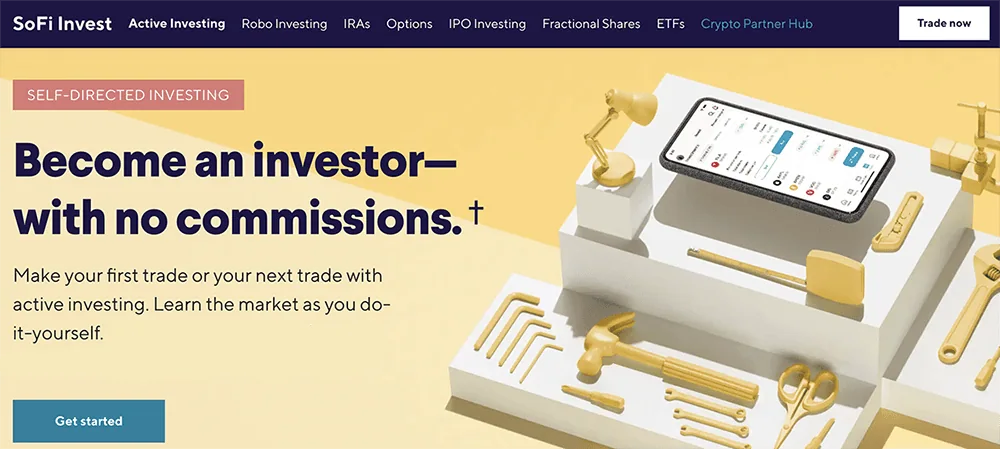
- Available: Sign up here
- Best for: Traders looking for an all-in-one personal finance experience
- Platforms: Web, mobile app (Apple iOS, Android)
SoFi is a multi-faceted financial company that offers everything from credit cards and insurance to student loans and mortgages … and they also allow you to trade and invest through its SoFi Invest app.
With SoFi Invest, you can invest as actively or as passively as you’d like.
The Active SoFi Invest Brokerage Account has no required minimum balance, charges no commissions on stock, ETF, and options trades, and its options trading has no contract fees, either.
The interface is still very much geared toward younger, less experienced investors—everything is focused on simplicity and ease of use, rather than an expanse of sophisticated tools. SoFi also offers budget-friendly features such as fractional shares, which allow you to invest for as little as $5. And SoFi even provides a social element, such as bringing SoFi members together at exclusive events.
Want to put your portfolio on autopilot? SoFi’s robo-advisory services will create a portfolio for you for an annual 0.25% assets under management fee (that can be designed to address one or several goals) and auto-rebalance it for you as necessary over time.
SoFi also occasionally has sign-up bonuses attached to its brokerage accounts, which you can read more about below. You can also visit SoFi Invest to learn more or sign up today.
- SoFi Invest allows you to trade or invest in stocks, ETFs, and options with no commissions and no account minimums. You can also participate in some initial public offerings (IPOs).
- Invest for as little as $5 with fractional shares.
- Robo-advisory services, including goal planning and auto-rebalancing, available for annual 0.25% AUM fee.
- Subscribe to SoFi Plus to unlock more than $1,000 per year in extra value, including a 1% match on recurring investment deposits, preferred IPO access, higher cash-back rewards on certain SoFi credit cards, a six-month APY boost, and more.
- Special offer: Get up to $1,000 in stock when you open and fund a new Active Invest account.*
- Good selection of available investments
- No options contract fees
- DIY and robo-investing options
- Fractional shares
- No mutual funds
- Limited trading tools
- No tax-loss harvesting
- No socially responsible robo-advisor functionality
Related: 9 Best Robo-Advisors for Investing Money Automatically
2. Robinhood (Best Simple Stock Trading App for Beginners)
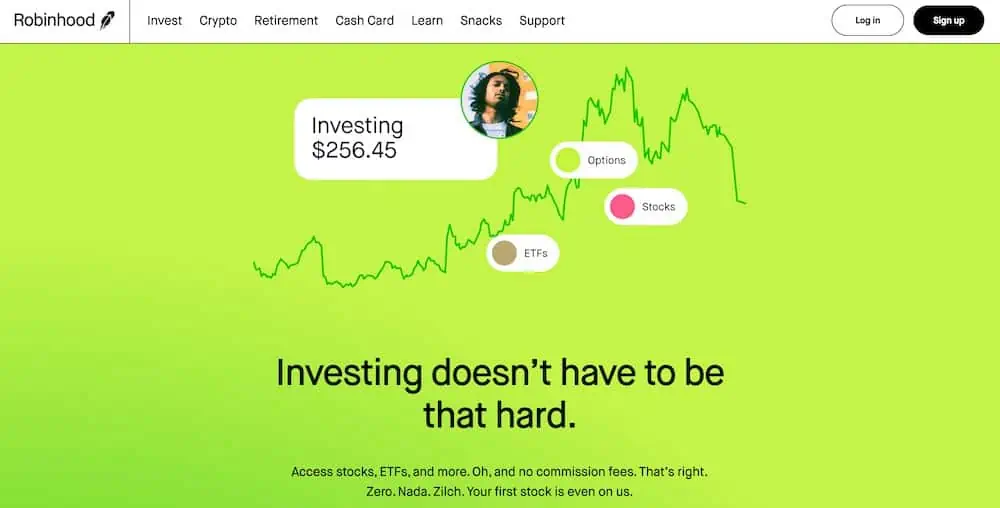
- Available: Sign up here
- Best for: Beginner traders
- Platforms: Web, mobile app (Apple iOS, Android)
Robinhood is a pioneer of commission-free trading, jumping into the investing public’s consciousness in 2013 when they rolled out commission-free trading. They remain a standout option for cost-minded investors thanks to their continued $0 commissions on stocks, ETFs, and options, as well as for its fractional trading, which allows people to invest with as little as $1.
More importantly, though, Robinhood has evolved from a bare-bones app appealing to mostly beginner investors to a fuller-featured account suitable for a wider range of experience levels.
For instance, Robinhood now offers individual retirement accounts (IRAs) and Roth IRAs via Robinhood Retirement. Functionally, it comes up short compared to many other IRA providers because of its investment options. It offers just stocks and ETFs; like with its brokerage account, mutual funds aren’t available. Options aren’t currently available, though Robinhood has explicitly stated that options will be made available soon.
Robinhood has long catered to younger investors with its gamified interface and growing library of educational content. But over the years, it has added a boatload of other features for new and experienced investors alike. Advanced Charts, for instance, provides simple and customizable charts with a variety of technical features. Robinhood’s Options Strategy Builder simplifies the options-trading process by helping you build a strategy based on what you expect your target stock or ETF will do in the future.
If you want to keep your banking and investing close together, you can also add a Robinhood spending account. This FDIC-insured account includes a Robinhood Cash Card issued by Sutton Bank—however, if you don’t want this physical debit card, you do have the option of having a virtual debit card only. The Cash Card is compatible with Apple Pay, Google Pay, and Samsung Pay, and also provides you with access to fee-free withdrawals from more than 90,000 ATMs. The card allows you to round-up purchases and invest the money into your brokerage or crypto account.
Sign up for a Robinhood brokerage account or Robinhood retirement account today.
- Robinhood is a pioneer in the investing app world, offering commission-free trades on stocks, ETFs, options, and cryptocurrency, as well as one of the deepest libraries of investing educational content.
- Investing for retirement? Robinhood will match 1% of any IRA transfers or 401(k) rollovers, as well as any annual contributions*, made to your Robinhood Retirement account—and you can get a 3% match on any new contributions if you subscribe to Robinhood Gold.
- Want more advanced trading tools? Download Robinhoold Legend—a desktop trading platform with real-time data, customizable layouts, deeper asset analysis, and more—for free.
- Robinhood's robo-advisory service, Robinhood Strategies, will build you a custom portfolio of stock and bond ETFs (and individual stocks for accounts with at least $500), for a low 0.25% in AUM, which is capped at $250 annually for Robinhood Gold members.
- Robinhood Gold also includes Level II market data provided by Nasdaq, higher interest rates on uninvested brokerage cash, lower margin trading rates, bigger Instant Deposits, and access to the Robinhood Gold Card (a 3% cash-back Visa credit card).
- Special offer: Sign up for Robinhood, link a bank account, and fund your account with at least $10, and receive a randomly selected cash amount between $5 and $200 to put toward certain fractional shares.
- Very good selection of available investments in brokerage accounts
- 1% match on rollovers, IRA transfers, and new contributions to IRAs and Roth IRAs (3% new-contribution match with Robinhood Gold)
- Automated recommended portfolios
- Intuitive interface
- Robo-advisory service (Robinhood Strategies)
- Extensive educational library
- No mutual funds in brokerage or IRAs
- Match doesn't apply to Robinhood Strategies accounts
Related: Best Robinhood Alternatives
3. Interactive Brokers (Best for Day Traders)
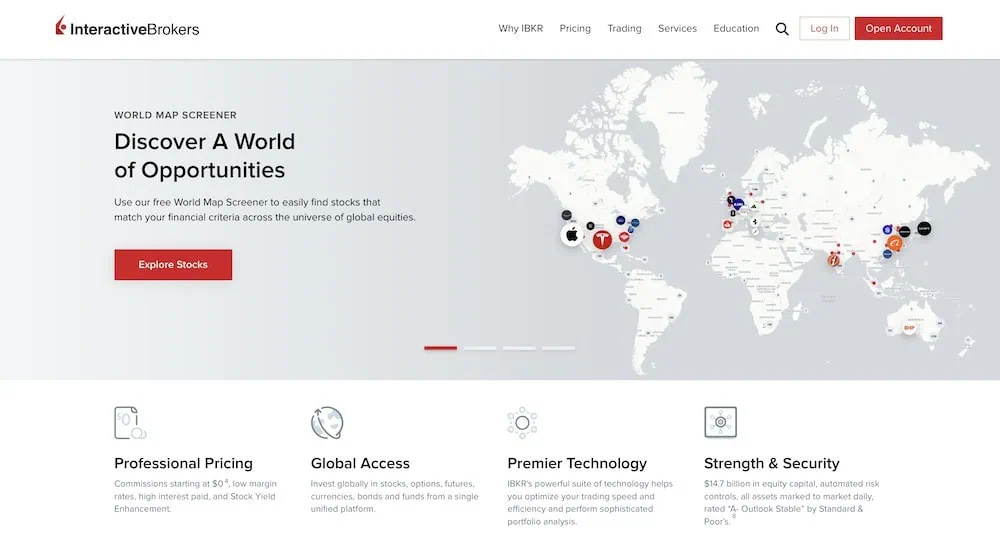
- Available: Sign up here
- Best for: Advanced and professional traders seeking low margin rates
- Platforms: Desktop app (Windows, macOS), web, mobile app (Apple iOS, Android)
Interactive Brokers (IBKR), founded in 1978, is one of the largest U.S. electronic trading platforms, offering traders access to stocks, bonds, funds, options, cryptocurrencies, foreign exchange, and more.
IBKR’s Trader Workstation (TWS) is Interactive Brokers’ flagship desktop program—a trading platform with roots back to 1995. But since then, the company has launched a number of other access points for brokerage accounts, including:
- IBKR Desktop: This desktop trading platform combines the most popular tools from its flagship Trader Workstation (TWS) with new tools such as a powerful MultiSort screener and Options Lattice, as well as a growing suite of original features suggested by IBKR clients.
- IBKR Mobile: A powerful app for iOS and Android that allows people to trade on the go
- IBKR GlobalTrader: A simplified app for iOS and Android that targets global traders, allowing deposits in up to 23 different currencies
- Client Portal: A lighter web-based platform allowing clients to manage their account, evaluate performance, and read market news
- IBKR EventTrader: A web-based platform allowing investors to trade “event” contracts (yes-or-no questions like “Will the S&P 500 Index close above 6,000 today?”)
- IBKR Impact: A mobile app that helps investors select holdings most in line with their values.
But Workstation remains the workhorse. The trading platform supports investments across 150 global markets, and offers a wide variety of features, including real-time monitoring, risk management tools, paper trading—all packaged under a heavily customizable layout day traders can use.
While TWS users can still select the original view, they can build their own bespoke view through Mosaic. Functions such as stock monitoring, order entry, charts, and more appear as “tiles,” sized and arranged however you want them, and you can save custom layouts designed for one or more monitors.
Trader Workstation also lets investors:
- Create example watchlists
- Use preset scans or build your own
- Create real-time trading alerts using price, time, margin, and volume
- Access more than 100 order types and algorithms to execute better trades
- Read breaking news from Reuters, Dow Jones, and other financial news outlets
- Access research from Morningstar, Zacks, and other firms
IBKR Lite/IBKR Pro
Interactive Brokers offers two primary plans—IBKR Lite and IBKR Pro—and both have no account minimums and zero maintenance fees. They also provide investors with access to many of the same features, including the Client Portal, Trader Workstation, and IBKR Mobile platforms; advanced order types; fractional shares of U.S. and European stocks and ETFs; paper trading; and Risk Navigator, which evaluates your risk in single positions or across your entire portfolio.
IBKR Lite is most suitable for beginner and intermediate investors, offering unlimited commission-free U.S.-listed stock and ETF trading, and fixed pricing for non-U.S.-listed stocks and ETFs, mutual funds, options, and futures.
IBKR Pro, meanwhile, is meant for advanced investors and active traders. While it does charge commissions on even U.S.-listed stocks and ETFs, it provides better execution for trades via its IB SmartRouting, which seeks out the best available prices for stocks and options across exchanges and dark pools—possibly resulting in lower spreads that offset the commissions you pay. It also offers better margin rates than Lite, though both platforms’ rates are among the best on offer.
Pro also offers some features not available on IBKR Lite, including higher interest paid on idle cash balances, lower interest charged on margin loans, backtesting, and access to IBKR APIs, which allow you to build your own custom trading applications and even develop commercial trading software—features often used by hedge funds, Registered Investment Advisors (RIAs), and proprietary trading firms. This makes the service our top pick for day trading platforms.
We should note that IBKR’s rating does get dinged (by both us and app-store users) for its sometimes buggy mobile-app experience. But the desktop app is a mainstay among advanced and professional traders.
You can visit Interactive Brokers to sign up or learn more.
- Trade stocks, bonds, ETFs, mutual funds, options, cryptocurrencies, foreign exchange, futures, micro futures, and futures options using the powerful legacy Trader Workstation desktop software or IBKR's web and mobile platforms.
- No account minimums, no maintenance fees with both IBKR Lite and IBKR Pro.
- Commission-free stock and ETF trading with IBKR Lite.
- Optimized trade execution and higher interest on cash balances with IBKR Pro.
- Earn interest rates of up to 4.08% on instantly available cash.
- Earn extra income on your lendable shares with IBKR's Stock Yield Enhancement program.
- Access features including watchlists, preset or customized stock scans, real-time trading alerts, advanced order types, and news and research from numerous leading providers.
- Excellent selection of available investments
- Extremely feature-rich desktop (Trader Workstation) and app (IBKR Mobile) platforms to satisfy even the most advanced traders
- Below-average options contract fees
- Trader Workstation Mosaic view is versatile and highly customizable
- Share lending program
- Robo-advisory services are available through Interactive Advisors
- Mobile app can be buggy, difficult to navigate, and sometimes has long load times
Related: 12 Best Investment Opportunities for Accredited Investors
4. Public.com (Trading App With Alternative Assets)
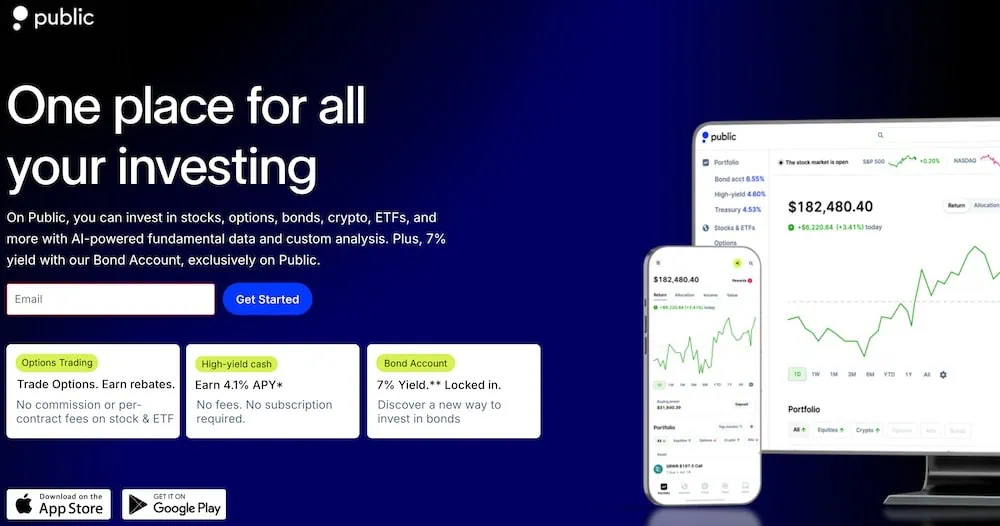
- Available: Sign up here
- Best for: New investors with limited capital
- Platforms: Web, mobile app (Apple iOS, Android)
Public.com is a commission-free investing app, geared toward Millennials and Gen-Zers, that as of late has built up the types of assets available to its users. On Public, users can trade not just stocks and ETFs, but also more than 25 different cryptocurrencies, and more recently, alternative assets from art to sneakers.
That last point is worth noting. Alternative assets are a relative rarity among stock trading apps. They can be difficult to research (and thus difficult to properly invest in), but they can provide uncorrelated returns compared to the stock and bond markets, so many savvy investors like to diversify into these assets.
The “Public” part of the name nods at the platform’s social aspect. For one, you can make your portfolio holdings open to other users, and conversely, you can look through other Public users’ portfolios. Investors can also connect with corporate founders and CEOs through live “Town Hall” meetings.
Public also acts as a micro-investing app, allowing you to invest in fractional shares with as little as $1.
While the number of tradable assets on Public.com is growing, it’s still somewhat limited: It doesn’t offer mutual funds, options, bonds, or futures. New users are also limited to individual brokerage accounts.
Users also can upgrade their experience with the $10/month Public Premium subscription.
Public Premium offers some features that are included in some free brokers’ services, but other features justify the cost. For instance, Premium offers extended-hours trading (8 to 9:30 a.m., and 4 to 8 p.m. Eastern) and stock price alerts—several competitors, such as TradeStation and E*Trade, deliver these services at no charge. However, Premium also provides:
- Advanced data on companies—Public.com’s examples include Tesla quarterly deliveries by model or Apple’s annual sales by continent
- Institutional-grade research provided by Morningstar
- Members-only analysis about events including major economic report releases, earnings announcements, and more
- Exclusive audio programming by Public.com’s expert analysts
What makes Public.com different?
Unlike other free stock trading apps found on this list, Public.com does not monetize its trading activity through receiving payment for order flow (PFOF). PFOF, in brief, is money that a market maker pays a brokerage firm for routing trades through that market maker.
Some investors have called out this practice as harmful to everyday investors, providing them with worse trade-execution prices than they would otherwise get—and this call grew louder amid the GameStop market mania in early 2021. In the wake of this event, Public.com announced a change in its revenue model, breaking with how many free stock apps generate income. Instead, it makes money off interest on cash balances, securities lending, and even tipping—users can choose to (but are not required to) tip Public when submitting trade orders. Public also will make money off its Premium subscription product.
By doing this, Public.com believes it’s better aligning its financial incentives with the best interests of its customers.
Read more in our Public.com investing app review.
For Public.com disclaimer, please see the fine print at the bottom of this article.
- Public.com offers zero-commission trading on thousands of stocks and ETFs, available as fractional shares. The app also allows you to invest in cryptocurrency, options, and bonds as well, and it's one of the rare brokerages that allows its users to buy alternative assets.
- Lock in a 5.3% yield with Public.com's Bond Account, which allows you to invest in a diversified portfolio of investment-grade and high-yield bonds.
- Use a social feed where members can share why they believe in certain companies (or don't) and can post comments on others' trades.
- Invest in curated lists of stocks and ETFs for people to aggregate investments by interest area or values.
- Subscribe to Public Premium for features such as advanced company-level data, Morningstar insights, and exclusive audio content from Public.com's expert analysts.
- Special offer: Receive an uncapped 1% match on transfers into a Public IRA.
- Fractional shares
- Good selection of investible assets
- Allows you to trade alternative assets
- No payment for order flow (PFOF)
- Creative social investing features
- Doesn't support mutual funds
- Limited investment research and other tools
Related: 11 Best Non-Stock Investments [Alternatives to the Stock Market]
5. Tastytrade (Trading App With Live Trading Video Feed)
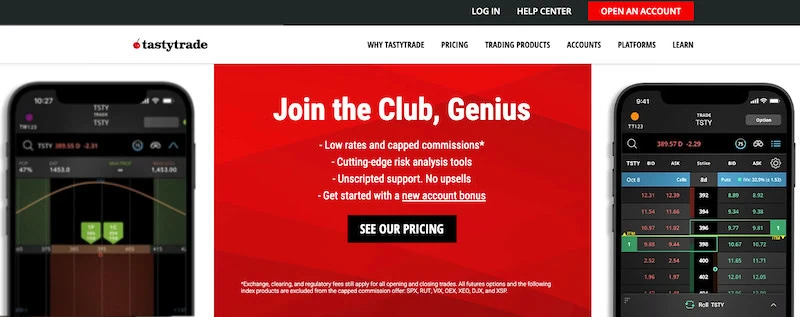
- Available: Sign up here
- Best for: Traders
- Platforms: Web, mobile app (Apple iOS, Android)
Tastytrade is an award-winning, self-directed brokerage started by the original founders of the famous thinkorswim trading platform, which was purchased by TDAmeritrade and subsequently bought by Charles Schwab.
The service charges no commissions for stocks, ETFs, and cryptocurrencies, and competitive commissions on options ($1/trade on stock and ETF options), futures, options on futures, commodities, and indices.
The platform offers the chance to experience cutting-edge, game-changing technology that anticipates next generation needs from traders. And one of the ways Tastytrade excels is their charting tools. They’re robust, interactive tools with over 250 available technical studies traders can use to analyze price and volume action in securities they follow. Traders can detach chart windows from the main trading screen to spread across a multi-monitor setup to keep eyes on several securities at once. Further, the stock charts allow for near endless customization so each trader can have the individual setup best suited to their needs.
The service aims to fix “trader’s block,” or the trader’s equivalent to writer’s block. It offers the ability to track traders on the platform and engage in video-feeds with other people to discuss all things markets. The service also partners with Tastylive, a financial news network entirely focused on talking shop about trading. Tastytrade says the services, when combined, can “transform you from a timid beginner to a confident, everyday trader.”
If you’re new to Tastytrade, they have ongoing incentives to make signing up for an account worthwhile. Learn more by visiting the Tastytrade site, opening an account and seeing if the trading platform’s stock charts handle your needs.
- Tastytrade is a self-directed brokerage offering stocks, ETFs, options, crypto and futures trading.
- Company started by original founding Thinkorswim team.
- Relies on competitive rates and cutting-edge technology to empower individual retail traders.
- Deposit Bonus: Get $50-$5,000 when you open and fund a new account with Referral Code "MYNEWBONUS".*
- Low trading costs, especially for higher volume traders
- Intuitive and easy-to-use trading platform
- Strong research and analytical tools
- Education-focused platform with live programming
- Fee structure favors more active traders
- Limited tradable products
- No interest on idle cash balances
- No mutual funds offered
6. E*Trade (Best for Intermediate Investors and Traders)
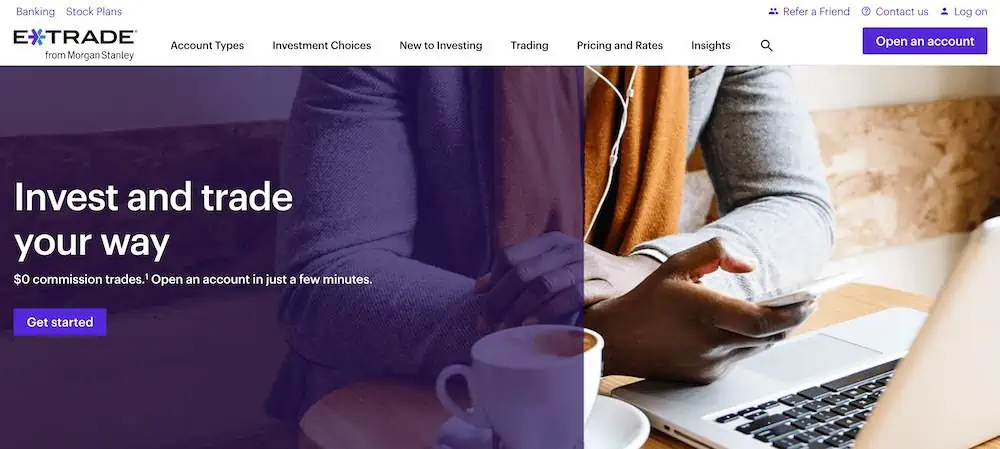
- Available: Click “Open Account” below
- Best for: Intermediate investors and traders
- Platforms: Web, mobile app (Apple iOS, Android)
E*Trade has long been seen as a leading stock trading app for retail investors. E*Trade provides investors access to educational resources that assist you with conducting investment research and analysis and diversifying your portfolio.
E*Trade, like most of the best stock investing apps, offers zero-commission stock, ETF, and options trading. It also has a leg up on some platforms by offering $0 commissions on mutual fund, Treasury, and new-issue bond trading. Investors also have access to futures, micro futures, and futures options, among other investment types.
Like with many zero-commission options trading platforms, though, options still have contract fees. Equity and index options are 65¢ regularly, though they’re reduced to 50¢ if you place more than 30 stock, ETF, or options trades per quarter. (E*Trade also has an options program called the “Dime Buyback Program.” If you close an equity option priced at 10¢ or less, E*Trade won’t charge you a per-contract fee.) A couple other fees worth noting are futures ($1.50 per contract) and secondary bond market trades ($1 each).
E*Trade has two platforms, both of which are free, and both of which have web and mobile versions:
Power E*Trade
Power E*Trade is designated for more intermediate-to-advanced traders. Features include:
- Advanced charting that includes intraday and historical options; more than 100 studies; over 100 drawing tools; and the ability to automatically identify technical patterns
- Snapshot Analysis, which lays out risk-reward probabilities in your options trading
- Powerful stock and trade scanner; use preset filters or customize as you wish
- Paper trading to test out strategies without putting your money at risk
- Ability to design exit strategies
Like with the Power E*Trade web platform, the Power E*Trade app is a more powerful version of its basic counterpart. This app allows you to use preset scans, work with interactive charts, place complex options trades, and more.
E*Trade
The “basic” E*Trade web platform might be more suitable for beginning-to-intermediate traders and investors, but that doesn’t mean it’s short on features.
E*Trade’s main web platform includes everything you need to keep up to date on your portfolio, including real-time quotes, charts, market commentary, and stock news. The latter includes free access to Bloomberg TV, Thomson Reuters, and TipRanks research. Meanwhile, you’ll have ample research tools at your disposal, including stock, mutual fund, bond, and ETF screeners; trade optimizers; backtesters; and more.
E*Trade also touts its educational resources, which includes articles, videos, and classes, as well as monthly webinars and live events. But we will note that its educational content is difficult to sort through.
Other considerations
Like with a couple other trading apps on this list, E*Trade also allows you to earn additional income by allowing the firm to borrow your fully paid-for holdings. E*Trade also offers retirement planning to clients as well as some in-person informational sessions.
For a limited time, E*Trade offers a new account funding bonus (when you use reward code “OFFER25”) in the following amounts:
- $1,000-$4,999 earns $50.
- $5,000-$19,999 earns $150.
- $20,000-$49,999 earns $200.
- $50,000-$99,999 earns $300.
- $100,000-$199,999 earns $600.
- $200,000-$499,999 earns $800.
- $500,000-$999,999 earns $1,000.
- $1,000,000-$1,499,999 earns $3,000.
- $1,500,000-$1,999,999 earns $5,000.
- $2,000,000 or more earns $6,000.
To open a free E*Trade brokerage account, click “Open Account” below.
- E*Trade is one of the best online and mobile trading platforms among discount brokers, offering a full range of investments (including professionally managed accounts). It allows you to invest in stocks, ETFs, mutual funds, options, bonds, futures, micro futures, and futures options.
- $0 commission trading for online U.S.-listed stocks, ETFs, options, mutual funds, Treasuries, and new-issue bonds. (Options have a 65¢ contract fee, or 50¢ at certain volume thresholds.)
- Opening an account is easy and only takes a couple of minutes.
- Bonus: Get between $50 and $10,000* when you click the box below, then open and fund a new investment account using promo code "OFFER25."
- Excellent selection of available investments
- Commission-free mutual funds and Treasuries
- Automated portfolio builders and prebuilt mutual fund and ETF portfolios
- Separate apps for power users and casual users
- Limited availability of fractional shares (only in DRIP plans or robo-created portfolio)
- No direct cryptocurrency trading
Related: 9 Best Real Estate Crowdfunding Sites + Platforms
7. NinjaTrader (Best for Technical Analysis Tools and Free Paper Trading for Beginners)
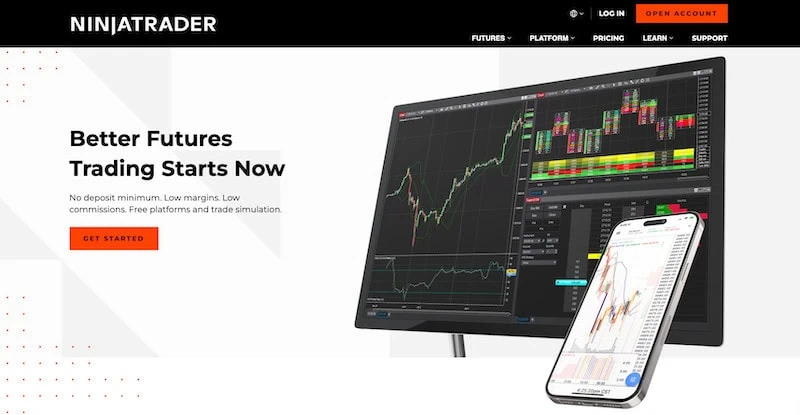
- Available: Sign up here
- Best for: Active traders specializing in day trading futures and forex (and other assets through third party brokers)
- Platforms: Desktop app (Windows), CQG mobile app (iOS and Android)
NinjaTrader is one of the oldest and best known trading platforms on the market. Specializing in technical analysis tools, real-time analysis, and a clean, fully customizable charting experience, NinjaTrader allows you to employ a fully automated trading strategy through its own brokerage service for futures, options on futures, and forex trading. And while that might seem like a limited set of assets (especially for being mentioned as a stock trading app and platform), NinjaTrader’s other core strengths are its ability to integrate with other brokers like IBKR, Schwab (TDAmeritrade), and others for an add-on fee and its NinjaTrader Ecosystem.
This community of vendors and plugins enrich the NinjaTrader experience through offering education-rich content for free and, among other things, allows you to attach NinjaTrader to several supporting brokerages to give traders access to other markets, including options on futures, contracts-for-differences (CFDs), and equities.
If you’d like to try using NinjaTrader for free, their basic platform features are free but come with higher commissions than you’d encounter under a paid account. This comes with charting, market analysis and live trading (and if you’d like to use their SIM trading environment, you don’t need a funded account). To use the software, visit the NinjaTrader website to install the software, launch the platform and start familiarizing yourself with everything you can do. You can open charts, customize colors, add indicators and strategies and insert symbols to a chart to take it for a test drive.
To access the full feature set (including more robust data like full market depth on CME or its CME bundle), you’ll need to pay added monthly fees: starting at $99 per month to lease the software or a $1,499 one-time payment to buy). Premium features include items like advanced order types, automated trading, and backtesting. And if you’d like more data, that’ll carry monthly costs as well: For CME Level I top of book data (CME, CBOT, NYMEX, and COMEX), it’s $12 per month and Level II costs $41 per month for non-professional users. Professional users pay $135 per month per exchange. ICE Market data also costs $140 per month per exchange for all users.
NinjaTrader’s robust community and suite of tools have established it as a leading charting software—be it for stocks, futures, forex, or other assets. The burgeoning educational guides, video library and free ongoing webinars provide ample access to the understanding traders need to hone their craft. Plus, the platform offers an easy (and free) way to learn what the platform can offer through its SIM trading environment. Consider signing up for a NinjaTrader account and taking the service for a test-drive.
- NinjaTrader is a brokerage account offering access to futures and forex directly, and several other asset classes through integration with third-party brokers.
- The robust charting tools, technical analysis capabilities, and real-time full depth of market data empower active traders to make informed decisions.
- The NinjaTrader Ecosystem offers access to thousands of vendors and plugins and includes a comprehensive educational offering for traders to improve their understanding and execution of trades.
- NinjaTrader offers a free SIM trading environment designed to employ what you've learned from their ecosystem's educational content without risking your own money.
- If you open and fund a NinjaTrader account, you'll receive up to $250 in commission rates for trades placed within 30 days of your funding date.**
- Excellent charting and technical analysis tools
- Partial and full strategy automation
- NinjaTrader Ecosystem offers apps and add-ons
- Free SIM trading environment suitable for beginners
- Robust educational guides, videos and webinars
- Trading equities requires using a supporting broker
8. Moomoo (Advanced Stock Trading App With Low Margin Rates)

- Available: Sign up here
- Best for: Advanced traders
- Platforms: Desktop app (Windows, Mac), web, mobile app (Apple iOS, Android)
Moomoo is a commission-free trading platform for stocks, ETFs, and options. While Moomoo is best for advanced traders, offering powerful tools to empower your trading insights and strategies, it takes a different approach from other similarly targeted platforms, favoring simple interfaces and high ease of use. The desktop platform is highly customizable, while the mobile app is straightforward, allowing you to search for stocks and trade with minimal hassle.
Still, Moomoo has more than enough under the hood for advanced traders to get the job done. Its charting system, for instance, includes 62 technical analysis indicators and 22 drawing tools. You can set up alerts based on changes in price, bids, turnover ratio, and more. Free Level 2 market data helps you get a greater understanding of a stock’s value, determine how liquid a stock truly really is, and better time your trades. You can even enjoy 24/7 financial news handpicked by Moomoo’s editorial team. The trading platform provides these features to empower investors to make better investing decisions.
One Moomoo feature worth noting is its mobile charting, which allows traders to take advantage of more than 60 investing indicators and 38 drawing tools. And any drawings or annotations you make are saved and synced with your profile so you can view them from either the app or your desktop.
While Moomoo isn’t as suitable to beginner traders, the trading platform does include some useful educational tools. For instance, paper trading functionality with real-time data simulates the investment experience without committing any of your real money. (This feature is also helpful to advanced traders, allowing them to test out strategies and hone their skills.)
Moomoo also boasts relatively low rates for trading on margin. The annualized interest rate on financing, as of this writing, is 6.8%—one of the most competitive rates among its peers.
The app pays you for giving it a spin by offering free stocks when you make a qualifying deposit after signing up. Specifically, you can get free stocks if you sign up for a Moomoo account and make a qualifying deposit.
If you want a professional-grade system for research and trading, but with a simpler user experience, Moomoo is among the best trading platforms to consider.
For Moomoo disclaimer, please see the fine print at the bottom of this article.
- Moomoo is an all-in-one investment app geared toward stock, ETF, and options traders who want to work with real-time market data at the ready.
- The service offers free Level 2 market data, offering more insight into the trading activity below the NBBO surface shown on many financial data sites.
- Use the service's powerful stock charting software capabilities to find trading opportunities.
- Get a great return on uninvested cash: Moomoo currently offers a 4.1% APY from its cash sweep program, though current promo offers 8.1% for a limited time.
- Special offer: New users get up to $1,000 in free NVDA stock when they sign up using our link and make a qualifying deposit,* as well as a three-month APY boost (to a total 8.1% APY on uninvested cash).
- Additional special offer for transfers: New customers who transfer assets into a Moomoo account can also receive a 3% match on their transfer up to $20,000 (for a reward cap of $600). New users who transfer in $50,000 or more and maintain for three days will also receive two suite tickets to a New York Mets game.
- Free Level 2 market data
- Free powerful stock charting software
- Free paper trading
- Low margin rates
- Fewer features than peers
- No robo-advisor functionality
Related: 13 Best Stock & Investment Newsletters for Inbox Alpha
9. Webull (Best Stock Trading App for Intermediate Traders)
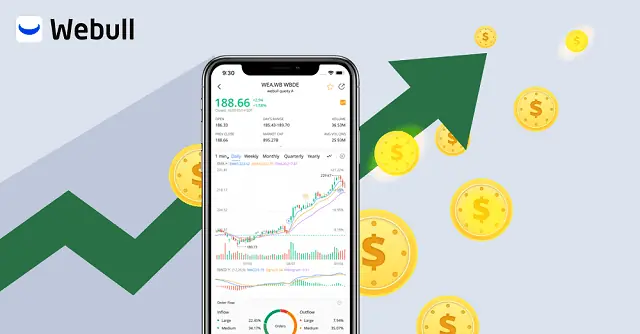
- Available: Sign up here
- Best for: Self-directed investors and intermediate traders
- Platforms: Desktop app (Windows, macOS, Linux), web, mobile app (Apple iOS, Android)
Webull first hit the investing world in 2018 and made a splash by offering free stock trading, as well as commission-free trading of exchange-traded funds (ETFs) and options. And since then, it has become one of the best stock trading apps for intermediate traders, though many of its features are helpful to beginner investors as well.
For one, Webull remains friendly to wallet-conscious traders today. It costs nothing to open a Webull account. Stocks, ETFs, and options still trade commission-free. Many options have $0 contract fees. And Webull has no deposit minimums. On top of that, it offers fractional shares, which allows investors to start buying for as little as $1.
Webull also is available across just about every platform, allowing you to research, trade, and track your stocks on your smartphone, tablet, or desktop.
Why choose Webull to trade stocks?
Webull provides traders with a number of useful features and tools, including:
- Customizable screeners for both stocks and ETFs
- Preset lists–including Top Gainers, Top Losers, Most Active, and Best-Performing Industries—traders can use to identify opportunities
- Free real-time stock quotes
- 12 charting tools and more than 50 technical indicators
- Real-time stock alerts you can set to notify you of events such as significant price action or certain technical conditions
- Numerous order types—simple orders such as limit and market orders, sure, but also group orders such as bracket, OTO, and OCO orders
- Quant ratings that help you to evaluate stocks through numerous lenses, such as growth, value, income, quality, and momentum
These tools make Webull one of the best stock research and analysis apps for traders.
Also noteworthy: Webull provides one month of free Level 2 Quotes powered by Nasdaq TotalView. Per Webull: “It provides the best 50 levels of bids and asks for all NASDAQ-, NYSE- and regional-listed stocks on NASDAQ Market Center. It includes the prices and quantities of displayed quotes and orders, allowing investors to better determine the availability or demand for a stock at a certain price.” Experienced day traders can use these quotes to try to determine where the stock market is headed in the very short term. (Note: Level 2 Quotes cost $2.99 per month after the free trial.)
And traders can even get paid for stocks they’re sitting on. Webull’s Stock Lending Income Program allows you to receive interest, accrued daily and paid monthly, for allowing Webull to borrow certain stocks. The interest rate varies widely depending on demand for a particular stock.
Webull also has a couple other fun (and still useful!) features. For instance, you can set up voice commands that will allow you to simply speak to buy, sell, or look up information on a ticker. There’s also “Big Button Mode,” which, as you’d guess by the name, populates giant buttons on your screen that allow you to quickly make trades with just a push.
We’ll point out that while Webull allows for many types of commission-free trades, other costs will still apply to a few transactions. For instance, a 55-cent contract fee applies to certain options trades. Webull doesn’t directly charge fees for trading cryptocurrencies, but it does build a 1-percentage-point markup into the price of cryptocurrency when you buy or sell crypto. And Webull’s margin rates, which are variable depending on the debit balance, are currently roughly middle-of-the-road.
You should also know that you can’t buy mutual funds on Webull, though that’s more of a concern for long-term investors and less so for traders.
Regardless, Webull remains one of the best, and most cost-friendly, trading platforms you can come across. And on top of all the free features mentioned above, Webull also runs frequent promotions that allow investors to collect free stocks.
Read more in our Webull review, or sign up at Webull today.
- Webull is a low-cost trading and investing app that allows you to invest in stocks, ETFs, options, futures, commodities, and crypto, and even participate in initial public offerings (IPOs).
- No-commission stock, ETF, and option trades (and many options have $0 contract fees).
- Trading features such as charting tools, technical indicators, customizable screeners, real-time stock alerts, and group orders.
- Let Webull manage your money for you with Webull Smart Advisor, which combines Webull's in-house investment expertise and artificial intelligence to build, manage, and rebalance an ETF portfolio for you.
- Sign up for Webull Cash Management to earn up to a 4.1% APY on uninvested cash.
- New users get one free month of Nasdaq TotalView's Level 2 Quotes service. (That subscription costs $2.99/mo. thereafter.)
- Subscribe to Webull Premium and receive a premium APY on uninvested cash in individual and joint cash accounts, premium margin rates, a 3% match when you transfer or roll over your IRA, and an extra 3.5% match on qualifying IRA contributions.
- Special offer: Make an initial deposit of at least $2,000 and receive 1.) a $100 cash bonus, 2.) a 2% match of your deposit (up to a maximum bonus of $20,000), 3.) a 30-day voucher for Webull Premium, 4.) a 30-day 4.0% APY booster on uninvested cash (for a total of 8.1%).**
- Good selection of available investments
- Fractional shares
- Powerful technical analysis tools
- Offers robo-advisory services
- Accessible to beginning and intermediate users
- Voice commands
- Offers highly competitive APY through Webull Cash Management
- Does not support mutual funds
Related: 15 Best Investing Research & Stock Analysis Websites
10. Cobra Trading (Best for Customer Service and Stock and Options Trading Costs)
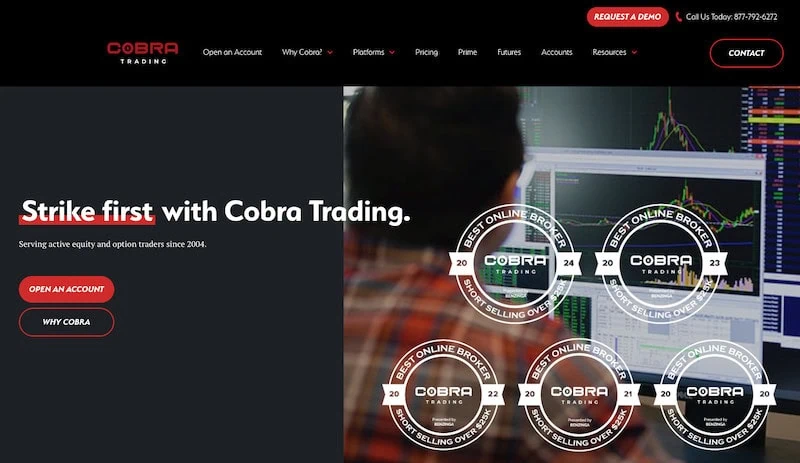
- Available: Sign up here
- Best for: Professional day traders seeking low commissions and excellent customer service
- Platforms: Desktop app (Windows), web, mobile app (Apple iOS, Android)
Cobra Trading is a direct access broker that offers a host of sophisticated trading tools day traders leverage to execute trades fast and efficiently. Armed with a proactive and responsive Customer Support Team, Cobra Trading caters toward the needs of institutional and retail traders seeking low trading commissions and Locate Costs.
The trading platform is specifically designed to cater toward professional traders with comprehensive trading needs. And not just any professional trader, but ones that focus on volatility in the markets to capture returns. Namely, that means traders who day trade, short, trade options (the platform only supports stocks, ETFs, and options at present—if you’d like to trade futures, you can access Cobra Trading’s companion service, Venom Trading).
While the tradable assets are fairly narrow in scope compared to other trading platforms, in addition to highly responsive Customer Service, where it excels is having impressive short locates. The platform offers one of the most impressive inventories of short opportunities in the market. And if you’re a swing trader who carries long and short positions in your Cobra account, you won’t pay overnight locate multiplier fees that many brokerages charge. Further, the firm’s direct access allows for better execution on position entries and exits at better pricing, bringing down the cost of trading for active traders.
Cobra Trading also offers a Cobra PRIME package, a curated suite of deeply discounted trading solutions and cutting-edge tools and resources. To qualify, you’ll need to be among Cobra Trading’s most active traders and trade at least 200,000 shares per month and maintain that average going forward. (If you trade more, you’ll move into a higher Cobra PRIME tier, enabling you to select more choices.) If you don’t qualify, you can still purchase the software of your choosing at Cobra’s discounted rate.
Cobra offers three trading platforms (software fees waived if trade 200,000+ shares/mo.):
- DAS Trader Pro ($125/mo.): Platform includes advanced order types, basket trading, charting, and multi-account management in real-time
- Sterling Trader Pro ($150/mo.): Direct-access trading platform for trading equities and options
- Cobra TraderPro ($100/mo.): Integrates Cobra Trading with TradingView, allowing you to trade on the charting platform.
One trade-off for opening an account with Cobra Trading are the high account minimums: U.S. and non-U.S. residents need $30,000 to open a day-trading account with a $25,000 minimum daily balance required (SEC requirement). If you’re not day trading, the minimum is less and starting deposits can be as low as $3,000.
In short, this platform isn’t meant for aspiring traders—only serious traders will have interest in using Cobra Trading to handle their equity and option trades (users can trade futures through their companion Venom Trading service or stocks, options, futures and forex on the same interface through their clearing firm agreement with InteractiveBrokers). But if you meet the above minimum requirements, prize exceptional customer service, speed and savings, Cobra Trading might be worth exploring for your active trading needs.
- Cobra Trading is a direct access broker equipped to handle active traders' equity and options trades at competitive commissions and contract rates.
- Cobra is one of the best short-selling specialists available, offering one of the most robust shortable inventories of equities in the market. Fees are extremely low, and it doesn't charge overnight locate multiplier fees.
- Cobra is available on three trading platforms: DAS Trader Pro, Sterling Trade Pro, and TradingView.
- Extremely active traders can qualify for Cobra PRIME: a suite of deeply discounted trading solutions, as well as cutting-edge tools and resources.
- Cobra Trading requires a $27,000 minimum initial deposit for pattern-day traders ($3,000 otherwise). Pattern-day trader accounts must maintain a minimum balance of $25,000.
- Large universe of shortable stocks
- Cobra PRIME offers access to free or deeply discounted curated trading solutions
- Low, transparent commission structure
- Responsive customer service
- Platform fee
- High account minimum ($30,000 on day-trading accounts)
- Limited selection of tradable asset types
Related: 9 Best Stock Charting Apps [Free + Paid Software Options]
Related Questions on Stock Investing Apps
Below you will find several frequently asked questions related to free investing apps.
Can I trade stocks for free?
Nowadays, it’s common to pay nothing to trade stocks. But that hasn’t always been the case. It wasn’t until 1975, when President Gerald Ford signed the Securities Acts Amendments of 1975, that brokers could even adjust the price of their commissions—they were fixed. For comparison’s sake, shortly after that, commissions per trade were in the $40-$50 range. By the 1990s, brokerage commissions had fallen to anywhere between $5 and $30 per trade.
Trading costs continued to decline until hitting a new frontier in 2013, when brokerage app Robinhood offered the first zero-commission trades. To stay competitive, almost every major U.S. brokerage began to provide the same.
Now, by and large, most outlets commission-free stock and ETF trades at a minimum, with some also offering commission-free options and/or mutual fund trades.
Fees aren’t completely gone, however.
Many brokerages still charge contract fees on options, for instance, and others charge for mutual fund trades. They also tend to charge for trading more complicated assets, such as futures, forex, and cryptocurrency.
Brokerages also make money in other ways, such as interest on margin loans, fees for premium services, and lending user-owned securities.
The good news for casual/beginner traders: You typically won’t be impacted by these fees. However, frequent traders, or those who trade more exotic assets, will have to deal with them—but they sometimes can access premium accounts that cut down on these particular fees.
Want to learn more about these brokerages’ business models? Check out “How Does Robinhood Make Money?“
Can you invest for free?
Just like trading, yes, you can invest for free.
If you’re a long-term investor, commission-free stock and ETF trading is really all you need to be able to build a buy-and-hold portfolio. If your preference is for long-term investing only, you should also focus on a platform that offers fee-free mutual fund trades as well, which you can pair with ETFs (or use them on their own) to build a diversified set of holdings.
Also pay attention to the type of investment accounts you’re allowed to open within a platform. Webull, for instance, allows not just taxable brokerage accounts, but also tax-advantaged traditional IRAs and Roth IRAs.
Related: 5 Best Investment Accounts for Kids [Child Investment Plans]
What are free stock trading apps?
A stock trading app is simply the software you use to buy and sell stocks and other securities through a brokerage. So, for instance, if E*Trade is your broker, then the stock trading apps you could use to access that would include the E*Trade mobile app and the Power E*Trade mobile app.
Virtually all brokerages have mobile apps, as well as web apps (versions of the software you access through a browser). Some platforms, such as Interactive Brokers and Moomoo, have desktop apps—apps that live on your computer and operate separately from your browser. Most of the time, desktop apps are the most powerful version of a brokerage’s software.
For the most part, “free stock trading apps” is simply another way of saying “free brokerage accounts.” A brokerage won’t have you sign up for an account for free, but then charge you for their mobile account. However, in a few instances—such as Axos Self-Directed Trading, with its Elite subscription—a trading platform might offer an additional premium subscription that provides additional benefits.
What are the best stock trading apps?
We feel all of the following apps have something to offer prospective stock traders. In no particular order …
What is the best stock trading platform?
Based on our review of all the available stock trading apps in the market, we believe Webull offers the most compelling stock trading app overall. It offers an intuitive interface and design, useful analytics tools, easy trading and charges nothing for commissions.
Because this app likely covers most retail investors’ needs, we rate it as the best stock trading platform for beginning to intermediate traders.
That said, not everyone is an intermediate trader, so …
What is the best stock trading app/broker for beginners?
The best stocking trading app for you depends on your experience, trading goals, and desired level of educational support. Beginners benefit from low fees, simple interfaces, and educational tools. They’re all the more useful if they can double as stock news apps. Social features can also help beginner investors stay more involved.
E*Trade is a popular choice for beginners because it combines many of the above elements, including free trading of stocks, ETFs, options, and mutual funds; well-designed mobile apps; educational resources; and bonuses for new users.
Of course, you can sign up for more than one app—in fact, some people prefer test-driving numerous investment platforms to see what they’re most comfortable with. And many apps allow you to try them out before having to fund the account with real money.
A few other beginner apps to consider:
- Public.com offers a simple interface, several investment options (including alternative assets, which are difficult to find in most other stock trading apps), and the ability to let people see your portfolio, as well as see other users’ portfolios.
- Webull, while best for intermediate investors, is still a good choice for beginner investors because of its low costs, educational materials, and intuitive interface.
- Robinhood is another platform that was built upon casual retail investors. While it has since buffed up its tools to become more attractive to more experienced traders, its interface, educational tools, and Snacks letter are all great features for beginners.
Related: 10 Best Stock Advisor Websites & Services to Seize Alpha
How do I teach myself to trade stocks?
Despite what you might have seen in certain movies, you shouldn’t trade stocks based on guesses or gut feelings. You need to learn the basics—how to evaluate a stock’s fundamentals, read charts, place orders, etc.
Ideally you can take classes or have a mentor teach you. But it’s also possible to learn how to trade stocks all on your own.
You can study the practices and teachings of successful investors such as Warren Buffett. You can also immerse yourself in investment websites, books, articles, videos, and news segments.
Of course, some people prefer homework, while others prefer labs. So for some, one of the best ways to teach yourself stock trading is to practice. But … how do you trade stocks to gain experience without spending your hard-earned money?
For those nervous about spending your hard-earned money, you’re in luck. It’s possible to build up your confidence by first practicing stock trading through a simulator.
Webull, Interactive Brokers, and Schwab are among brokers and trading apps that offer “paper trading”—a free simulator that allows you to try out hypothetical trades to see what your profit or loss would have been based on your decisions.
And, of course, those interested in learning how to invest money can keep browsing through Young & The Invested, where we offer plenty of investing-focused articles.
Can I start trading with $100?
There has never been a better time to start investing with little money—even a solitary Benjamin. With a little focus, you can really stretch $100 into quite a powerful starter portfolio.
For one, start with a brokerage or trading app that has no minimum required deposit and no commissions on at least stock and ETF trading—which is basically just about every product we mentioned above. That keeps more of your money out of the brokerage’s pocket, and more of it buying stocks and funds.
We’d also suggest going with a company that offers fractional shares on stocks at the very least, if not also exchange-traded funds.
While the dollar amount a stock trades for typically doesn’t say much about the quality of a stock—a $50 stock isn’t necessarily any better than a $100 stock, for instance—uber-cheap stocks (those that trade under $5, but especially “penny stocks,” which trade under $1) tend to be riskier than most. So, if you have to buy whole shares, $100 won’t get you very far—maybe three or four companies—and you’ll be locked out of many popular stocks that cost triple-digits for just one share!
But with fractional shares, you can typically invest as little as $1 in each individual company, allowing you to spread your money around many different companies. This is called “diversification” and helps protect you against a decline in any single stock.
Another option is to invest in an indexed ETF or mutual fund (or two, or three). Index funds are typically cheaper than their actively managed counterparts, but they still allow you to own numerous stocks, bond, or other assets for very low annual fees—often just a few cents per year on that $100 you’re investing. That said, a few of the most popular index funds trade for more than $100 per share, so using an app or brokerage that offers fractional ETF shares is a great way to maximize your money.
Related: 10 Investments that Earn a Great Return [10% or More]
Are stocks trading apps safe?
Absolutely.
That’s not to say you can’t/won’t lose money from investing in stocks. While stocks typically go up in the long term, many people experience losing years, and some overly aggressive investors can lose a lot by making just a few bad choices.
But if you do lose money, it shouldn’t be because of the brokerage service itself. These accounts offer Securities Investor Protection Corporation (SIPC) insurance on any cash held in them, as well as a variety of other investor protections.
How do I choose the best stock trading apps?
The best stock trading app for me isn’t necessarily the best stock trading app for you.
Maybe you’re more experienced with options. Maybe you’ve only started investing. Maybe you want as many research tools as possible. Maybe you rarely trade, so all you care about is a clean, simple interface that’s easy to use when you need it.
Your preferences are ultimately what will determine which app or brokerage account is best suited for you.
When we compiled this list of the best stock trading apps, we considered a number of features that are important to traders of varying experience levels. Among them?
- Commissions and other fees
- Account minimums
- Margin rates
- Stock charts
- Stock screeners
- Stock alerts
- Fractional shares
- Breadth of assets to invest in (stocks, ETFs, mutual funds, options, bonds, etc.)
- Educational materials
- Robo-advisory services
- Access to news and research
- Real-time market data
- Trading programming languages
- Intuitive interfaces
- Social experiences
- Other noteworthy features
Naturally, our best stock trading apps naturally include a large number of these features. But even then, a few of them are subjective.
For instance, one person’s easy-to-use app might be a chore to someone else. A library of educational articles might be attractive to you, but your best friend might prefer video lessons. Access to Reuters news might not appeal to you, but you might want to tap into Morningstar’s research.
Thus, we encourage you to base your decision on what’s important to you—not just on what we’ve deemed the best. Also, if you’re looking to trade CFDs for short-term movements with leverage such as currencies, shares or indices then we recommend viewing the CompareForexBrokers platform guide.
What are the advantages of using an investing app to trade stocks?
When we say “investing apps,” we’re talking about platforms that either prioritize long-term investing or have plenty of trading features but still have everything that long-term investors need.
The biggest advantage of using investing apps to trade stocks is they often have lower fees on more basic trading functions, and/or have a wider variety of basic trading functions that are low- or now-cost. They’ll also often have stronger educational libraries for those just getting started.
Many investing apps are attractive to both beginner and experienced traders. Firstrade, Webull, and TD Ameritrade stand out—yes, they have plenty of features that very much make them attractive investing apps for long-term investors, but they’re also teeming with features that are appropriate for intermediate and advanced traders.
What are the disadvantages of using an investing app to trade stocks?
The downside of some investing-focused apps is that they either have higher costs for advanced trading, or their tools aren’t as robust as active traders want/need. Mobile investing apps in particular are designed for simplicity, often intentionally narrowing options for better ease of use, while mobile trading apps might be a little clunkier but offer far more functionality.
This might raise the question: “Should I use a stock trading app and an investing app?”
It depends on what you need, and how much more added complexity you want in your day. On the one hand, using two apps would give you one platform with, say, lower options contract fees, better margin rates, and excellent tools that help you shape your stock trades—and another that, say, allowed you to easily search and research long-term holdings, and buy mutual funds for free.
But while you absolutely want to practice diversification in your portfolio, do you necessarily want to diversify where your money is held? Spreading your investments across stock app after stock app makes it even more difficult to keep track of your overall portfolio.
The Best Commission-Free Stock Trading Apps and Platforms
Free stock trading apps are becoming more and more popular. No surprise here. For one, being able to trade fee-free, with a small amount of money, and from the convenience of your smartphone, has made stock trading accessible to more people than ever before.
And thanks to pushes in financial education, more people want to invest than ever before.
Whether you’re a beginner trader or more of an expert, there are stock app options to fit your needs. So, take one or more of the stock apps above for a spin, and start investing toward your future.
Related:




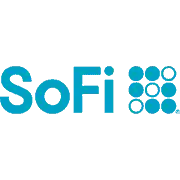

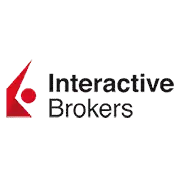

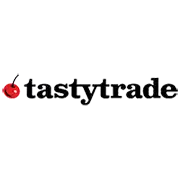
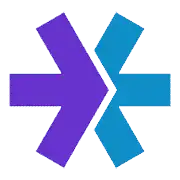
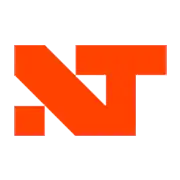

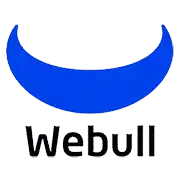
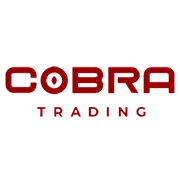
![8 Best Portfolio Analysis Tools [Portfolio Analyzer Options] 79 best portfolio analysis tools](https://youngandtheinvested.com/wp-content/uploads/best-portfolio-analysis-tools-600x403.jpg.webp)
